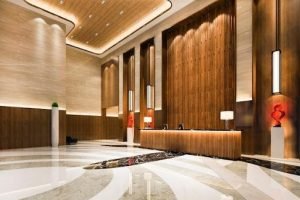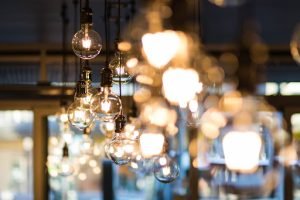Lighting is essential for creating depth and height, cozy spots, and attracting attention to the most striking areas. It all comes down to the right balance between light and shadow and how it brings new life into an interior. During lighting design a designer or architect may only include a grid of downlights in their plans for your space, but this will not do justice to the work they have done. Your space will be more impactful if you have lighting professionals working in synergy with your architect or interior designer.
Your home’s entrance lighting design should be welcoming to guests. It should also provide a seamless transition from bright sunlight to interior lighting. The lighting should be dimmed at night to allow visitors to relax and transition from the darkness outside into the interior. Lighting should be dimmed before bed to encourage “winding down” but bright enough to allow you to navigate your home safely.
What is designer lighting?
A decorative lighting feature, such as a pendant or wall light that is dramatic or interesting, can do more than add beauty to a space. Although our eyes may naturally gravitate to large, pleasing pendants over tables, a few down lights on either side can enhance the lighting. A good lighting designer will combine architectural lighting with decorative lighting to achieve the best results. You can turn the decorative lighting on to enjoy a relaxing late-afternoon atmosphere. Other times, you may need more lights.
How can lighting Design be improved?

Lighting should be considered from the beginning when designing your space. Collaboration with a lighting designer and involving them in discussions with your electrician, architect, and other professionals interested in the project will ensure everyone is on the same page. A collaborative design process will ensure a smooth project and a better chance of a great result.
Three lighting design principles are essential to designing the best lighting systems.
-
Function
A room should be well lit to allow all its occupants to navigate it safely. It is essential to consider the intended functions of the space so that the light serves them.
-
Aesthetics
Although function is the most important aspect of lighting design, it’s not the only thing that matters. Designers who are experienced know how to maximize space’s psychological and physical impact without compromising its functionality. Great architecture is built around the effects of light and daylight.
-
Energy Efficiency:
Today’s architects are responsible for designing sustainable lighting systems. This means using energy-efficient lighting options and letting in more natural sunlight by using passive daylighting systems.
Each building has a unique architectural lighting design approach that meets these three requirements. By thinking strategically about lighting design at the beginning of design, you can explore all options to make each project a success.
Lighting design improves flexibility.


Lighting design offers flexibility. It’s easier than ever to set the right mood in your space with the ever-growing advances in technology and lighting control.
Working with a professional lighting designer who has experience in intelligent lighting controls and dimming, you can choose between pre-set lighting scenes and many other options. Because of the positive impact lighting rules can have on customer experience, they are becoming more popular in hospitality. Restaurants can control lighting intensity and mood throughout the day, which is a great advantage. To help customers wake up, a brighter atmosphere can set in the morning. However, a more intimate and relaxed mood can be created during the evening.
How light and architecture work together during lighting Design


Before discussing how light and architecture interact during the process of lighting design. it is essential to understand the main types of buildings and their respective goals with lighting. Public buildings include libraries, hospitals, sports arenas, and libraries. These buildings provide the best light conditions for various events and tasks. For sporting events such as football or baseball, the light must be sufficient to allow the players and spectators to see each other. It is also crucial for spectators who need to move around the arena or stadium. The same applies to hospitals and libraries. Libraries need adequate light levels for their occupants to read, write, and locate books on shelves. Hospitals require high light levels to enable doctors and nurses to do their jobs well.
READ NEXT: Tips for buying a perfect chandelier for a living room
RELATED TOPICS: Home Lighting Design






